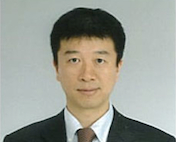Molecular Radiology
Molecular Radiology
)
)
Associate
Professor
Noriko Hosoya
Lecturer
Atsushi Enomoto
1. Summary
We are continuously exposed to various genotoxic insults such as ionizing radiation, hazardous chemicals and endogenous metabolites. Among DNA lesions caused by these insults, DNA double-strand breaks (DSBs) are the most serious. Despite their prevalence, these lesions can be properly repaired to avoid deleterious consequences in general.
If the machinery of DNA repair is defective, genomic instability that may lead to tumor formation is induced. For example, it is well known that mutations in genes involved in homologous recombination (HR) repair for DSBs are responsible for hereditary breast and ovarian cancer. PARP inhibitors are effective in HR defective cancers based on the principle of synthetic lethality. Inhibition of the DNA damage response proteins can be used to sensitize cancer cells to radiotherapy and chemotherapy.
Thus, knowledge gained from the study of DNA repair has considerable potential to impact the development of precision oncology. Our research focus is on the molecular mechanism underlying genomic instability in order to shed novel light on cancer treatment.
2. Research aims
-
To understand the molecular basis of genomic instability
-
To identify how the signals from genomic alterations to cell functions are regulated
-
To investigate opportunities for novel therapeutic approaches to cancer
3. Publications
- Enomoto A, Fukasawa T, Tsumoto H, Karube M, Nakagawa K, Yoshizaki A, Sato S, Miura Y, Miyagawa K: Prevention of calpain-dependent degradation of STK38 by MEKK2-mediated phosphorylation. Sci Rep 9:16010, 2019.
- Yasuhara T, Kato R, Hagiwara Y, Shiotani B, Yamauchi M, Nakada S, Shibata A, Miyagawa K: Human Rad52 promotes XPG-mediated R-loop processing to initiate transcription-associated homologous recombination repair. Cell 175:558-570, 2018.
- Hosoya N, Ono M, Miyagawa K: Somatic role of SYCE2: an insulator that dissociates HP1α from H3K9me3 and potentiates DNA repair. Life Sci Alliance 1: e201800021, 2018.
- Yasuhara T, Suzuki T, Katsura M, Miyagawa K: Rad54B serves as a scaffold in the DNA damage response that limits checkpoint strength. Nat Commun 5:5426, 2014.
- Hosoya N, Okajima M, Kinomura A, Fujii Y, Hiyama T, Sun J, Tashiro S, Miyagawa K: Synaptonemal complex protein SYCP3 impairs mitotic recombination by interfering with BRCA2. EMBO Rep 13:44-51, 2012.

